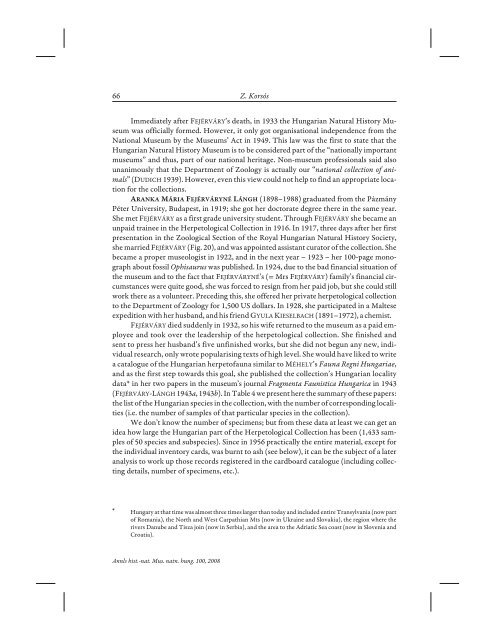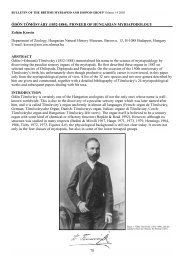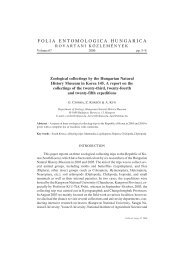History of the Herpetological Collection of the ... - Korsós Zoltán
History of the Herpetological Collection of the ... - Korsós Zoltán
History of the Herpetological Collection of the ... - Korsós Zoltán
You also want an ePaper? Increase the reach of your titles
YUMPU automatically turns print PDFs into web optimized ePapers that Google loves.
66 Z. Korsós<br />
Immediately after FEJÉRVÁRY’s death, in 1933 <strong>the</strong> Hungarian Natural <strong>History</strong> Museum<br />
was <strong>of</strong>ficially formed. However, it only got organisational independence from <strong>the</strong><br />
National Museum by <strong>the</strong> Museums’ Act in 1949. This law was <strong>the</strong> first to state that <strong>the</strong><br />
Hungarian Natural <strong>History</strong> Museum is to be considered part <strong>of</strong> <strong>the</strong> “nationally important<br />
museums” and thus, part <strong>of</strong> our national heritage. Non-museum pr<strong>of</strong>essionals said also<br />
unanimously that <strong>the</strong> Department <strong>of</strong> Zoology is actually our “national collection <strong>of</strong> animals”(DUDICH<br />
1939). However, even this view could not help to find an appropriate location<br />
for <strong>the</strong> collections.<br />
(1898–1988) graduated from <strong>the</strong> Pázmány<br />
Péter University, Budapest, in 1919; she got her doctorate degree <strong>the</strong>re in <strong>the</strong> same year.<br />
She met FEJÉRVÁRY as a first grade university student. Through FEJÉRVÁRY she became an<br />
unpaid trainee in <strong>the</strong> <strong>Herpetological</strong> <strong>Collection</strong> in 1916. In 1917, three days after her first<br />
presentation in <strong>the</strong> Zoological Section <strong>of</strong> <strong>the</strong> Royal Hungarian Natural <strong>History</strong> Society,<br />
she married FEJÉRVÁRY (Fig. 20), and was appointed assistant curator <strong>of</strong> <strong>the</strong> collection. She<br />
became a proper museologist in 1922, and in <strong>the</strong> next year – 1923 – her 100-page monograph<br />
about fossil Ophisaurus was published. In 1924, due to <strong>the</strong> bad financial situation <strong>of</strong><br />
<strong>the</strong> museum and to <strong>the</strong> fact that FEJÉRVÁRYNÉ’s (= Mrs FEJÉRVÁRY) family’s financial circumstances<br />
were quite good, she was forced to resign from her paid job, but she could still<br />
work <strong>the</strong>re as a volunteer. Preceding this, she <strong>of</strong>fered her private herpetological collection<br />
to <strong>the</strong> Department <strong>of</strong> Zoology for 1,500 US dollars. In 1928, she participated in a Maltese<br />
expedition with her husband, and his friend GYULA KIESELBACH (1891–1972), a chemist.<br />
FEJÉRVÁRY died suddenly in 1932, so his wife returned to <strong>the</strong> museum as a paid employee<br />
and took over <strong>the</strong> leadership <strong>of</strong> <strong>the</strong> herpetological collection. She finished and<br />
sent to press her husband’s five unfinished works, but she did not begun any new, individual<br />
research, only wrote popularising texts <strong>of</strong> high level. She would have liked to write<br />
a catalogue <strong>of</strong> <strong>the</strong> Hungarian herpet<strong>of</strong>auna similar to MÉHELY’s Fauna Regni Hungariae,<br />
and as <strong>the</strong> first step towards this goal, she published <strong>the</strong> collection’s Hungarian locality<br />
data* in her two papers in <strong>the</strong> museum’s journal Fragmenta Faunistica Hungarica in 1943<br />
(FEJÉRVÁRY-LÁNGH 1943a, 1943b). In Table 4 we present here <strong>the</strong> summary <strong>of</strong> <strong>the</strong>se papers:<br />
<strong>the</strong> list <strong>of</strong> <strong>the</strong> Hungarian species in <strong>the</strong> collection, with <strong>the</strong> number <strong>of</strong> corresponding localities<br />
(i.e. <strong>the</strong> number <strong>of</strong> samples <strong>of</strong> that particular species in <strong>the</strong> collection).<br />
We don’t know <strong>the</strong> number <strong>of</strong> specimens; but from <strong>the</strong>se data at least we can get an<br />
idea how large <strong>the</strong> Hungarian part <strong>of</strong> <strong>the</strong> <strong>Herpetological</strong> <strong>Collection</strong> has been (1,433 samples<br />
<strong>of</strong> 50 species and subspecies). Since in 1956 practically <strong>the</strong> entire material, except for<br />
<strong>the</strong> individual inventory cards, was burnt to ash (see below), it can be <strong>the</strong> subject <strong>of</strong> a later<br />
analysis to work up those records registered in <strong>the</strong> cardboard catalogue (including collecting<br />
details, number <strong>of</strong> specimens, etc.).<br />
* Hungary at that time was almost three times larger than today and included entire Transylvania (now part<br />
<strong>of</strong> Romania), <strong>the</strong> North and West Carpathian Mts (now in Ukraine and Slovakia), <strong>the</strong> region where <strong>the</strong><br />
rivers Danube and Tisza join (now in Serbia), and <strong>the</strong> area to <strong>the</strong> Adriatic Sea coast (now in Slovenia and<br />
Croatia).<br />
Annls hist.-nat. Mus. natn. hung. 100, 2008




